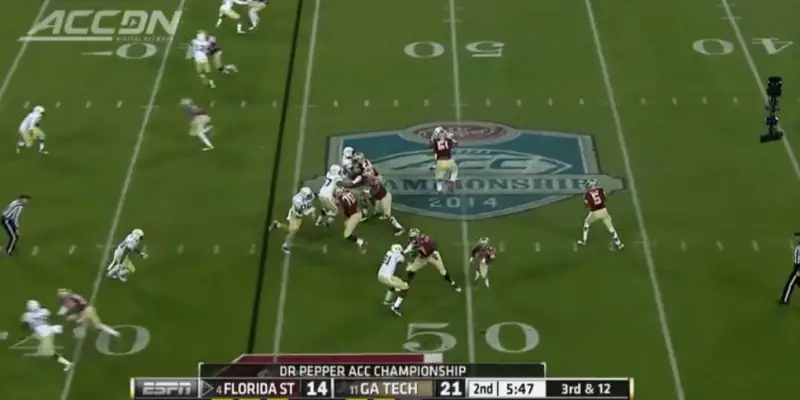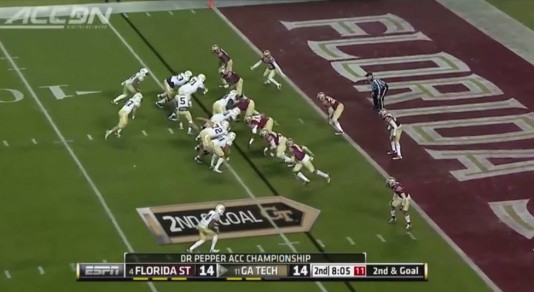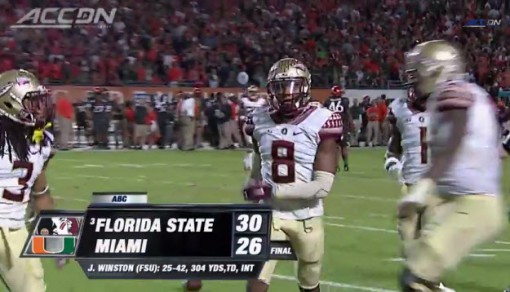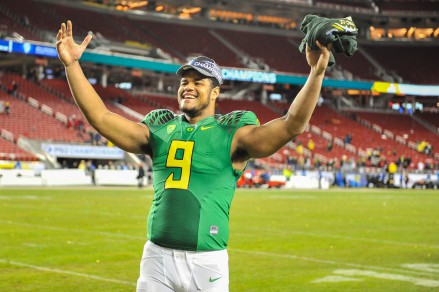Mike Merrell’s Three-and-Out
Florida State’s ability to win close games this year is an enigma. Is it a team strength that the Seminoles always seem to snatch victory from the jaws of defeat? Or is it a weakness that they find themselves needing to often enough to give their fans ulcers?
In 2012 and 2013, Stanford was that sort of team, and it made no exceptions for the Ducks, which appeared to be an elite team. Two years ago, Notre Dame was that sort of team, and when it came up against an elite Alabama team in the BCS Championship Game, it got blown out.
Over half of Florida State’s wins this year have been by less than seven points — not always against the greatest of competition — and trying to make some sense of it all is the subject of this week’s Three-and-Out.
1. Florida State as a Team. For starters, the Seminoles aren’t the same team they were in 2013. Seven Seminoles went in the first five rounds of last year’s NFL Draft, and they lost five of their top six tacklers. Still, Athlon Sports picked them as the Number 1 team in its preseason poll. While Athlon’s call may end up being right, the Seminoles have certainly not been the offensive juggernaut that Athlon projected them to be.
Karlos Williams averaged eight yards per carry while running for 730 yards last year, and was expected to contribute even more this year. But he’s only run for 609 yards on 4.4 per carry. Freshman Delvin Cook has taken up some of the slack, averaging 5.8 yards per carry for 905 yards. But with a rushing offense that is ranked 104th in the country, Florida State is hardly Stanford of recent history. Its offensive line is experienced and big – in the 305 to 335 pound range – but somehow that has not translated into an ability to grind out drives consistently.
Still, Florida State is good on third down, converting 74 of 160 for 46.3 %. But the Seminoles are zero for four on fourth down. Oregon — with a stronger running game — is better, converting 89 of 174 on third and picking up another 16 conversions on fourth down.
The Seminoles have had their share of injuries, but certainly less than the Ducks, and certainly not enough to account for so many close calls against middling teams. Key injuries to watch with the Rose Bowl approaching are to defensive tackles Eddie Goldman (6’4″, 320) listed as probable, and Nile Lawrence-Stample (6’1″, 314) listed as questionable. Running back Williams is also listed as questionable with a concussion.
2. How Florida State Has Won. The popular thinking is that Jameis Winston has time and time again led the Seminoles to comeback victories. There’s some truth to this in the wins over Notre Dame and Miami, which the Seminoles outscored 21-10 and 20-3, respectively, in the second half. But the last time the Seminoles scored a second half touchdown was November 15, against Miami. They were held to single field goals in the second half against Boston College and Florida, and Georgia Tech limited them to three second half field goals. So the ‘Noles have averaged exactly five second half points over the past three games.
A greater contribution seems to be defensive halftime adjustments. Since giving up 21 second half points to Oklahoma State in the season opener, in its close games this year Florida State has surrendered double digit second half points only to Georgia Tech (14) and Notre Dame (10). Clemson and Boston College had a touchdown apiece and Miami and Florida each were limited to a field goal. So the greater threat to the Ducks appears to be getting shut down in the second half.
However, coaches Helfrich, Frost and Pellum have proven adept at second half adjustments for the Ducks, as well. And while FSU has a bit of a weight advantage on both sides in the trenches, the Ducks have the advantage in height and reach. A critical factor often overlooked is how many (and how hard of) hits quarterbacks take in the first half, and the Oregon D-line has pounded its share of the talent out of more than one QB this year. Another advantage for a defensive line is having the height to look over the top and see where a play is going. On the other side of the ball, tiring out Oregon’s offense has proven tough to pull off, and the Ducks have played stronger defenses than FSU.
3. Jameis Winston. Searching for the biggest enigma in FSU 2014 leads to the Heisman vs Heisman matchup of Winston vs Oregon’s Marcus Mariota. A number of sources credit Winston as being a more accurate passer than Mariota. Commentators credit his ability to throw into tight windows, where Mariota throws to wide open receivers. But there’s a problem with this. Winston has thrown 17 interceptions this year to Mariota’s two. Assuming that the competition from the defenses that each has faced is similar enough that it’s all from the same planet, there are two possibilities: either Mariota is the more accurate passer by far, or Mariota excercises better judgment in choosing his targets (among other things).

This accurate pass by Winston into a tight window resulted in one of his 17 interceptions this year.
Most quarterback comparisons consider arm strength, accuracy, running ability, intangibles, clutch play, etc. “Judgment” doesn’t seem to be listed among anybody’s defining factors. Yet all factors have limited value if a quarterback overestimates his ability two or three times a game and throws ill-timed picks. Winston has made some great decisions on the field, but as is the case off the field, he has also made some poor decisions on the field. At least seventeen of them to Mariota’s two. And Winston’s touchdown production is way down from last year as well.
So the 2014 edition of Florida State remains an enigma — at least until the first day of 2015. Have the Seminoles played just slightly better than mediocre teams because they themselves are mediocre? Or are they among those who, despite not having the greatest talent, have the greatest heart and rise to any occasion? Or are they among the opposites, those who play down to the level of inferior competition, always doing just enough to get by, no matter the circumstances — and at some point have it all catch up to them?
With no common opponents, it is difficult to know how Florida State and Oregon stack up. Under the transitive property (which though often criticized, is about 90 % accurate), Florida State is fairly comparable to Notre Dame, and Notre Dame did not fare so well against Pac-12 opponents that were nowhere near as good as Oregon.
On paper, talent-wise Florida State looks great. But if it really is that great, despite a second consecutive undefeated season, its greatest achievement in 2014 has been hiding its ‘A’ game. Scoring an average of five in the second half worked against Boston College, Florida and Miami. Against Oregon? Probably not.
Top photo from video
Related Articles:
Chip Kelly Update: Everything's Good Again ...
Chip Kelly Update: Wailing and Gnashing of Teeth
Shock and Awe -- The Oregon Ducks' Football Hangover Effect
Despite Lopsided Score, Georgia State "Never Stopped Believing"
Hope Springs Eternal for Ducks
Incompetent Pac-12 Officials: How Do You Miss ALL of THIS?
Mike (Editor-in-Chief) is a 1970 graduate of the University of Oregon where he attended the Honors College and received all-conference honors as a swimmer. After college, Mike ran for the Oregon Track Club and narrowly missed qualifying for the US Olympic Trials in the marathon. He continues his involvement in sports with near-daily swimming or running workouts, occasional masters swim competition (where he has received two Top-10 World rankings), providing volunteer coaching to local triathletes and helping out with FishDuck.com.
Mike lives on 28 acres in the forest near Sandpoint, Idaho, where he has served as a certified public accountant for most of his working career. His current night job is writing novels about Abby Westminster, the only known illegitimate daughter of Britain’s finest secret agent who has to bring down arch-villains plotting dastardly deeds. And, yes, Abby is also a DUCK!




